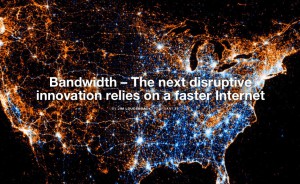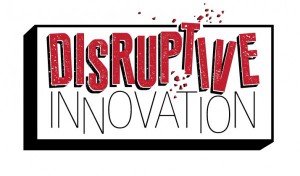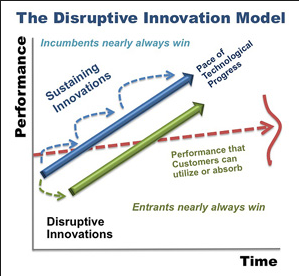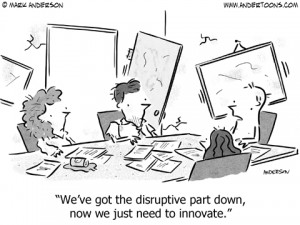Disruptive Innovation
Bandwidth and Disruptive Innovation
In this article, Louderback talks about how increasing bandwidth over the past few decades has disrupted different forms of media. The disruptions he discussed were:
1. Printing Publications
2. The Music Industry (disrupted by Napster, LimeWire, etc.)
3. Cable TV Companies
4. The Film Industry
However, now that we have the bandwidth capacity for accessing/streaming all of the traditional forms of media, Louderback identifies a couple trends of what new forms of media may be disruptive in the near future:
-Immersive Virtual Reality
-Personal Streaming (as seen in early experiments with SnapChat)
-Augmented Reality (Microsoft’s HoloLens)
But beyond these predictions, Louderback believes that the next disruptive media innovation may not have been invented yet. Do you guys agree with the trends that Louderback identified? Or do you have any other ideas on what new media disruptions might appear in the next decade?
Project Ara – The Next Disruptive Innovation for Smartphones?

Project Ara’s next prototype will stand equal to a top-tier smartphone
Project Ara: Part of it (YouTube video)
The smartphone market is filled with innovation; companies are always trying to outdo themselves in order to create a superior, albeit expensive, smartphone. Google, on the other hand, is looking to alter the current cycle with Project Ara. The goal is to create a modular phone. Rather than having to constantly buy new phones, you just simply upgrade certain parts to your phone. Want a faster processor? Then buy a faster one to put in your phone. Want a longer-lasting battery? Then buy a bigger battery to put in your phone. You have complete control over how you want your phone to be. In a smartphone market where people are very picky about what they want to have in a phone, Project Ara can potentially be a game-changer.
If Project Ara is a success, then I think it would be an example of a Low-End Disruption. Although there is no idea as to what the price of the phone and individual pieces would be, I think that the fact that you only have to buy the phone once will save you money over time. Also, since this phone is being developed by Google, it’s possible that the phone would be carrier-free, which is a popular option for the low-end market. It may take a little while for this to catch on, but I’m very excited by the prospects of a modular phone.
What do you guys think about this? Do you think Project Ara has the potential to be a disruptive innovation? If not, then what might Google be able to do with this project in order to make it so? And besides for Project Ara, can you think of any other future phone technologies that could be a disruptive innovation?
5 Benefits of Disruptive Innovation
As we all know, there are many benefits associated with disruptive innovation. The 5 benefits of disruptive innovation that I ran across in an article are:
- It helps businesses expand its market through innovation with new and existing products/services.
- It exposes businesses to the importance of urgency.
- It helps companies discover its present and future leaders.
- It helps companies discover future opportunities.
- The company culture can turn into a learning community that embraces change.
What are some other benefits of disruptive innovation? What are the disadvantages of disruptive innovation? What types of companies benefit most from disruptive innovation?
How to manage for disruptive innovation?
This week we’ve talked about how companies that are small in size are able to compete with bigger companies due to disruptive innovation. A compelling way to make sure that your company stays on top of disruptive innovation is to follow a very interesting 5 step process that I’ve came across in an article I read.
- Identify your company’s key markets. It is a good idea to access whether the market that your company competes in is going to be positively impacted or negatively impacted by the disruptive innovation so that you can properly manage the situation at hand before it’s too late.
- Identify priority markets. This will help you redefine your market segments and adjust segmentation criteria to suit your company’s needs.
- Analyze industry structure. Utilize Porter’s 5 forces to gain a good understanding of any options and opportunities that are out there.
- Identify what makes each player powerful. The best way to learn how to be the best is to learn from the best.
- Hypothesize on ways to disrupt the status quo. Collect ideas on what can be the next big thing and launch an innovation project for the ideas that seem the most feasible.
What are your thoughts regarding this approach? Do you think that companies that are the most successful regarding disruptive innovation follow this approach? Are there any steps missing or incomplete?
Growth from Disruptive Innovation
Disruptive Innovation An opportunity for growth
Khattab Al-Ali outlines what businesses should do in the face of disruptive innovation and how they can use them to grow. He recommends not trying to use an innovation that your business model cannot support as well as not following competitors into new business segments if they have expertise you don’t have. He says that listening to customers for what innovations to invest in is a good idea but not to give the customers everything they want on a whim, it does not always make good business sense. He also says when evaluating disruptive innovation you need to not only focus on the standard metrics. Some innovations have consequences that people would not originally think. Finally he says that when addressing the disruptive innovation you should separate it from your main business as to not add risk to your current business.
What do you think businesses should do when evaluating new innovations? How do you think the organization should structure these endeavors?
Why Disruptive Innovation is Not a Strategy
In light of our learning about disruptive innovation and reading about companies like Apple who have used it to their advantage, I found an article claiming that disruptive innovation is not a strategy and that companies should stop striving for it. The author, Soren Kaplan, explains how while many companies are striving to create disruptive innovation strategies, the inherent vagueness of the term makes it a lousy strategy. It’s not a linear method or process, and there is no way to capture how to do it.
The idea isn’t new- originally introduced in 1942 as “creative destruction” by economist Joseph Schumpeter, and it has since become an accepted paradigm, until Jill Lapore started to chip away at the idea. She believes that the concept of disruptive innovation “has been used as an argument for blowing up the broken healthcare and education systems, which minimizes the fact that these long standing institutions are complex social services delivered by human beings, not just stale technologies ready to be displaced by the next big thing.”
The author also goes on to explain how even one of the greatest innovators of all time, Steve Jobs, didn’t try to change the industry when he started Apple. He was quoted saying “When we created the iTunes Music Store, we did that because we thought it would be great to be able to buy music electronically, not because we had plans to redefine the music industry.” Kaplan goes in to cite the founders of Google as well, claiming that they too started with a basic vision, not a grand idea of disruptive innovation and changing the world.
Do you think that disruptive innovation is a sound business strategy? Is it something to strive for or is it just something that happens?
A Lesson in Disruptive Innovation
http://www.cio.co.nz/article/565828/lesson-disruptive-innovation/
Jon Rice and Sean Walters were able to take the concept of disruptive innovation and apply it to the recruitment industry (which they said “was ripe for innovation”) by founding virtualRPO. As it’s name implies, it is a virtual platform that provides companies with their own dedicated recruitment professional, whose services they only pay for when they use.
All of their systems are cloud based and they boast that they can “deliver a better hire for half the cost.” This especially appeals to high growth companies, such as My Food Bag, because virtualRPO has contingent, flexible services that don’t force permanent and salaried recruitment functions.
Lastly, there is currently a rise in demands (that isn’t being met) for experience with cloud software, mobile, Enterprise applications and big data analytics, which is causing something of a talent war in this market segment. Tech and SaaS firms are seeking very similarly skilled individuals, so they are essentially competing against each other. This is a great opportunity for virtualRPO, as a low-cost recruiter, as technological companies need to seek third party help to find people with these skills.








